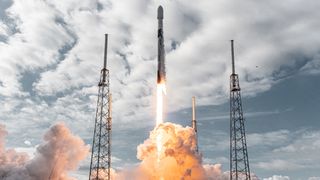SpaceX delays launch of Transporter-2 rideshare mission on Falcon 9 rocket
It was initially slated to launch Friday, June 25.

CAPE CANAVERAL, Fla. — SpaceX has delayed its next mission to allow for more prelaunch checkouts.
A SpaceX Falcon 9 rocket was scheduled to launch the mission, called Transporter-2, Friday afternoon (June 25). Instead, SpaceX is now targeting a new launch date that should be announced soon.
"Team is taking additional time for pre-launch checkouts ahead of the transporter-2 mission; will announce new target launch date once confirmed," the company tweeted on Thursday (June 24).
Related: SpaceX launches a record 143 satellites on one rocket, aces landing
The Falcon 9 first stage featured in this launch is one of SpaceX's veterans — a booster dubbed B1060. Embarking on its eighth mission, B1060 has carried five different Starlink internet satellite payloads, an upgraded GPS satellite for the U.S. Space Force, as well as a communications satellite for Turkey.
For its next act, the Falcon 9 will ferry dozens of satellites into space as part of the company's second dedicated rideshare mission. SpaceX's first rideshare flight, Transporter-1, launched in January, carried 143 small satellites — a new record for a single rocket.
Acting as a cosmic carpool, SpaceX sent the bevy of small satellites into space alongside 10 of its own Starlink internet satellites. The mission deposited the flat-paneled Starlink satellites in a unique polar orbit — a first for its broadband fleet that will help provide coverage to customers in Alaska and other polar regions.
Get the Space.com Newsletter
Breaking space news, the latest updates on rocket launches, skywatching events and more!
Transporter-2 won't be breaking any records with the number of satellites tucked inside its payload fairing, as this mission is expected to carry around 88 spacecraft, also into a polar orbit. Tucked inside the rocket's nose cone is a whole host of small satellites, including payloads for the U.S. military, plus radar and optical Earth observation satellites for Satellogic and ICEYE, which are commercial remote sensing companies out of Argentina and Finland. There are also numerous CubeSats on board.
Team is taking additional time for pre-launch check outs ahead of the Transporter-2 mission; will announce new target launch date once confirmedJune 24, 2021
The first stage booster will also deviate from the traditional drone ship landing, and touch down on Landing Zone 1 here at the Cape, marking the first land landing of the year.
The flight marks SpaceX's 20th launch of the year and the third to use the polar corridor since August 2020 — a flight path that hadn't been used since the 1960s. (Typically, polar launches blast off from places such as California or Alaska, so they can fly over unpopulated areas.)
That's because there was an incident with debris from a Thor rocket reportedly killing a cow in Cuba in the late 1960s. Rockets are equipped with flight termination software to destroy the rocket in the event of an anomaly during flight. (Historically, there would be a human in charge of the system, which isn’t as precise as a computer.)
SpaceX's Falcon 9 rocket is the first to be equipped with an automated flight termination system (FTS), which allows them to use the polar launch corridor. In the future, all new launch vehicles will be equipped with the same automated FTS.
SpaceX expects to announce a new launch date soon.
Follow Amy Thompson on Twitter @astrogingersnap. Follow us on Twitter @Spacedotcom or Facebook.
Join our Space Forums to keep talking space on the latest missions, night sky and more! And if you have a news tip, correction or comment, let us know at: community@space.com.

Amy Thompson is a Florida-based space and science journalist, who joined Space.com as a contributing writer in 2015. She's passionate about all things space and is a huge science and science-fiction geek. Star Wars is her favorite fandom, with that sassy little droid, R2D2 being her favorite. She studied science at the University of Florida, earning a degree in microbiology. Her work has also been published in Newsweek, VICE, Smithsonian, and many more. Now she chases rockets, writing about launches, commercial space, space station science, and everything in between.
